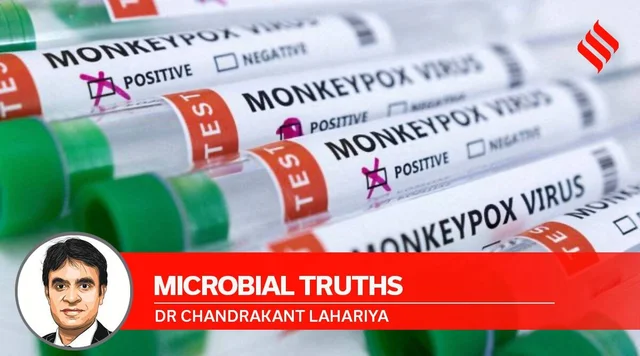‘The possibility of Monkeypox becoming a pandemic is very low,’ says epidemiologist
The first Monkeypox case in India was detected because the person affected volunteered to share information about his contact being tested positive. This is an example of how the success of effective disease surveillance is dependent upon citizen participation and community engagement. The solution is in the government and citizens working together, says epidemiologist Dr Chandrakant Lahariya
=============================
🔖 India’s first ever Monkeypox disease case was reported from Kerala on July 14 and now we have a second case too. To most public health experts, this has not come as a surprise. Since the first week of May, around 7,500 laboratory-confirmed monkeypox cases have been confirmed in nearly 55 countries which had never reported the disease. This is the biggest outbreak outside Africa, since the Monkeypox virus was first detected in humans in 1970.
.
🔖 The emergence and re-emergence of diseases, especially those of zoonotic (the one which jumps from animals to humans) origin, is becoming increasingly common. In the last eight decades, nearly 350 diseases have emerged and two-third of those were zoonotic in origin. SARS CoV1, Swine flu H1N1; Zika and SARS-CoV2 are some examples. This is because of multiple factors, which include rapid deforestation and increasing human intervention in forests; global warming and rising temperatures helping microbes to adapt and survive in new conditions; rapid and unplanned urbanisation, dense settlement and overcrowding; single animal livestock or “intensive” farming practices; indiscriminate use of anti-microbials, especially in the poultry farms and agriculture industry, and the increased wildlife trade.
.
🔖 In the interconnected world, no country has remained unaffected by the emergence of new diseases. In India, new viruses like Zika, Nipah and Crimean Congo hemorrhagic fevers have been detected in the last few years and are spreading. A recent scientific study has reported how the Zika virus spread to eight Indian states.
.
🔖 In this backdrop, the detection of Monkeypox cases in India is not a reason to worry or panic. However, it is time to activate the public health machinery at all levels. Monkeypox is largely a self-limiting disease and people recover without any treatment. In fact, though around 7,500 laboratory-confirmed cases have been reported in non-endemic countries, no death has been reported so far.
.
🔖 One of the key questions people have is whether Monkeypox can turn into a pandemic. Based upon current epidemiology, though, Monkeypox could move to a stage of public health emergency of international concern (PHEIC), a stage just prior to the pandemic. However, the possibility of Monkeypox becoming a pandemic is very low for a variety of scientific reasons. Unlike SARS CoV2, which is a respiratory virus and is airborne (particles and droplets both), the Monkeypox virus spread requires direct skin to skin contact with the affected person. In addition, unlike SARS CoV2, in which asymptomatic individuals can transmit the infection, for Monkeypox, only those with symptoms are infectious. Therefore, chances of transmission going undetected are negligible. Responding to Monkeypox would be relatively easy for public health authorities as it is not a new virus and a lot is known about its transmission and pathogenicity. In addition, it is a relatively stable virus with a very slow rate of mutations.
.
🔖 There is a silver lining in the COVID-19 pandemic response as nearly all countries have strengthened the disease surveillance system and laboratory capacity, a possible reason so many countries could detect monkeypox in an ongoing outbreak. The Ministry of Health and Family Welfare (MoHFW) in India had also released guidelines on the detection and management of Monkeypox disease by May 2022. Early case identification, contact tracing and isolation of contact remains the key to response.
.
🔖 There are some medicines and a few smallpox vaccines which are either approved and recommended for ‘off-label’ use against Monkeypox. However, these medicines and vaccines are not available in all countries. The vaccination of the general public is not recommended. Nonetheless, in India, it will be prudent that the National Technical Advisory Group on Immunisation (NTAGI) deliberate upon and come up with technical guidance on possible target groups and to plan, procure, stockpile and if needed deploy such vaccines.
.
🔖 As zoonotic diseases are becoming a reality, the preparedness and response to emerging and re-emerging diseases require mid to long term strategy. There is a need to strengthen the primary healthcare system, establish well-functioning disease surveillance systems, train public health workforce and focus upon the ‘One-health’ approach, where interventions are coordinated to protect the health of humans, animals and ecosystems.
.
🔖 Especially to tackle the challenge of shortage of human resources and funding for fighting infectious diseases and for surveillance systems, the recently announced initiatives, such as public health and management cadre and Ayushman Bharat Health infrastructure mission (ABHIM), should be implemented in an accelerated manner by all Indian states.
India being a global vaccine production hub, the government should enhance investment on vaccine research and focus upon international and domestic collaboration for research and development of effective medicines and vaccines against emerging diseases.
.
🔖 Interestingly, as with many other recently detected viruses in India, the first case of Monkeypox in India has also been reported from Kerala. This merely indicates the sustained performance of the disease surveillance system in the state, which is sensitive enough to detect even rare transmission.
The first Monkeypox case of India was detected because the person affected volunteered to share information about his contact being tested positive. This is an example of how the success of effective disease surveillance is dependent upon citizen participation and community engagement. Clearly, the governments need to take proactive measures to engage with the citizens. This is how India can fight Monkeypox, many endemic viral diseases such as chikungunya and dengue and any future emerging disease.
Cre: indianexpress
615
620
1
0
 HUDSON FRANKLINhttps://t.me/Franklin_Hudson01
HUDSON FRANKLINhttps://t.me/Franklin_Hudson01
Stay at home make money !..
Receive $5.500 every week direct to your wallet or bank account
(1) no hidden fee (2) no scam
Ask me how...
https://t.me/Franklin_Hudson01Haha
- Reply
- 2 years ago




